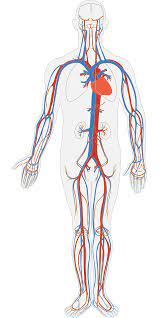Anatomy
Anatomy Of Blood Vessels, the arteries and veins
Blood Vessels:
Blood vessels are the interconnected tubes in which the blood flows in the body. Blood vessels are spread in the entire body like a network. In this article, we will study the different types of blood vessels and their significance. At the end as usual we will go through some important questions for the MDCAT.
Types of blood vessels:
On the basis of the direction of blood flow there are two types of blood vessels:
1. Arteries:
Arteries are simply those blood vessels that carry blood away from the heart. All arteries carry oxygenated blood from the heart except the pulmonary artery which carries deoxygenated blood from the heart to the lungs for oxygenation. The largest artery in the human body is the aorta that arises from the left ventricle and distributes the blood into the entire body.
Anatomy of an artery: To learn the anatomy of an artery we consider the cross-section of an artery.
This shows us that an artery is basically consisting of three layers or tunics:
1. Tunica externa/adventitia: The tunica externa or adventitia is the outermost layer of an artery. It is basically a connective tissue layer. It contains elastic and collagenous fibers.
2. Tunica media: The tunica media is the middle layer of an artery. It consists mainly of smooth muscle fibers. It also has some elastic tissue which is arranged in two laminas an outer external lamina and an inner internal lamina. It provides elasticity to the arteries allowing them to withstand the pressure of blood.
3. Tunica interna or intima: The tunica interna is the innermost layer of an artery. It is made of simple squamous epithelium also referred to as the endothelium. It allows a smooth flow of blood through it.
2. Veins: The veins are those blood vessels that carry the blood towards the heart. All veins carry deoxygenated blood towards the heart except pulmonary veins which carry oxygenated blood from the lungs towards the heart. The largest veins of the body are the vena cava which are the superior and inferior vena cava.
Anatomy of a vein: A vein has the same basic anatomy as an artery. A vein consists of the same three tunics just like an artery. The outermost layer is the tunica externa, the middle layer is the tunica media and the innermost layer is the tunica intima.
The basic difference in the anatomy of an artery and a vein: The basic difference between the anatomy of an artery and a vein is that an artery has a thicker tunica media layer whereas a vein has a slightly thin tunica media layer. Moreover, an artery has elastic laminas in the middle layer whereas a vein does not have. Thus arteries are made to withstand the pressure which exerted by the blood due to ventricular contraction. If an artery is punctured blood will spurt out whereas if a vein is punctured blood simply oozes out this is because pressure in arteries is greater than in veins. The most distinguishing feature of a vein is that it has valves to ensure one way blood flow whereas arteries don't have valves because one way blood flow is ensured by the pressure generated by the ventricluar contraction.
Capillaries: The capillaries are a network of thin walled blood vessels that interconnect arteries and veins. Capillaries have a single layer of simple squamous epithelial cells referred to as endothelium resting on a basement membrane. Capillaries are the blood vessels which are responsible for allowing nutrients and gases to pass from the blood into the tissues. Capillaries have a very small diameter through which the blood passes very slowly thus providing ample time for the exchange of nutrients and gases. Thus capillaries are used for exchange purposes between the blood and tissues.
Quick quiz for practice:
1. The blood pressure is the lowest in which vessels:
a. Arteries
b. Veins
c. Capillaries
d. none
2. Which circuit has more pressure:
a. Pulmonary circuit
b. Systemic circuit
3. Most elastic blood vessels are:
a. Artries
b. Capillaries
c. Veins
If you find this article interesting please comment down and share with your friends. This will motivate us to bring more quality content like this.








Post a Comment
2 Comments
Dn
ReplyDeleteIf it was helpful let us know
Delete